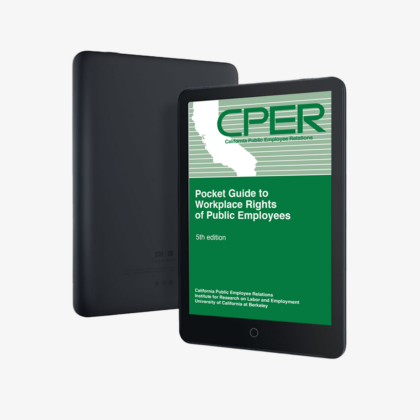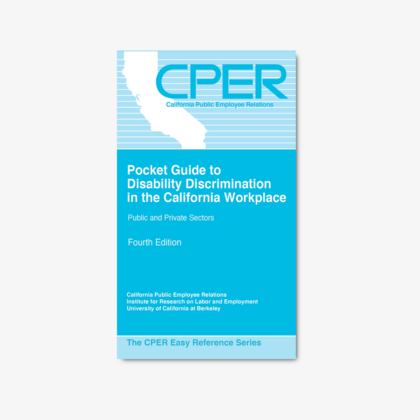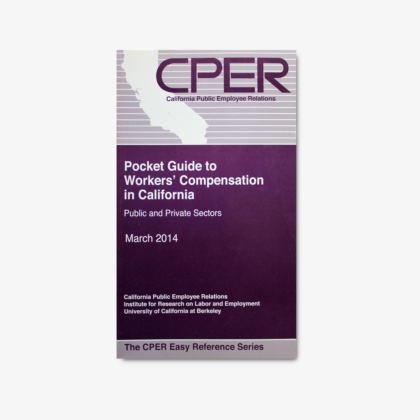Cause or just cause for discipline or discharge is a requirement in most collective bargaining contracts and public sector personnel or civil service rules. But how is cause defined? How do hearing officers and arbitrators assess whether discipline or discharge should be upheld? How should representatives for employers, unions, or employees prepare and present a disciplinary case?
The answers are in this Guide, which provides:
- A description of the “tests” that arbitrators apply to decide whether an employer had just cause for discipline or discharge;
- An explanation of how statutory law and collective bargaining agreements may limit the arbitrator’s traditional discretion;
- Advice to practitioners on how to evaluate a case, decide whether to settle a case, and if not, prepare for a hearing;
- Information on common remedies with an explanation of how statutory rights affect remedial awards;
- A description of the various statutory schemes for disciplinary hearings that govern the different sectors of public employment in California.
The guide is generally applicable to both arbitrations and civil service disciplinary hearings. Designed for use by labor relations representatives, union representatives, and lawyers, it provides a breadth and depth of coverage not available elsewhere at such an affordable price.
Table of Contents
- Introduction (Page 1)
- “Just Cause” — The Origin of the Principle (Page 1)
- “Just Cause” — The Definition (Page 1)
- Appellate review standard (Page 2)
- De novo review standard (Page 2)
- Employment At Will vs. Negotiated Just Cause (Page 3)
- “Just Cause” — The Definition (Page 1)
- Merit Systems vs. Negotiated Just Cause (Page 4)
- Local government (Page 6)
- State (Page 6)
- Schools and colleges (Page 7)
- Universities (Page 7)
- Non-Negotiated Disciplinary Appeal Procedures (Page 7)
- State Civil Service Employees (Page 8)
- California State University Employees (Page 9)
- Staff employees (Page 11)
- Academic employees (Page 12)
- University of California Employees (Page 11)
- Staff employees (Page 11)
- Academic employees (Page 12)
- Community College Employees (Page 13)
- Academic employees (Page 13)
- Classified employees (Page 14)
- K-12 Public School District Employees (Page 16)
- Permanent certificated employees (Page 17)
- Probationary certificated employees (Page 18)
- Local Government Employees (Page 18)
- Trial Court Employees (Page 20)
- “Just Cause” — The Origin of the Principle (Page 1)
- Just Cause — The Tests (Page 21)
- Elements of Just Cause (Page 21)
- Factors Arbitrators Use to Determine Proof of Misconduct (Page 22)
- Reasonableness of the Rule or Standard of Conduct (Page 23)
- Notice to the Employee of the Rule (Page 23)
- Notice of the Disciplinary Consequences (Page 24)
- Notice of the Charges (Page 24)
- Timely Action on the Charges (Page 25)
- Adequate and Fair Investigation (Page 25)
- Opportunity to Respond to the Charges (Page 26)
- Proof of the Charged Misconduct (Page 26)
- Equal Treatment for Similar Misconduct (Page 27)
- Double Jeopardy (Page 28)
- Factors Arbitrators Use to Determine Just Cause for the Level of Discipline (Page 28)
- Progressive Discipline (Page 29)
- Seriousness of the Misconduct (Page 29)
- Similar Penalty for Similar Misconduct (Page 30)
- Length of Service (Page 30)
- Prior Disciplinary Record (Page 31)
- The Employer’s Degree of Fault (Page 31)
- Other Mitigating or Aggravating Circumstances (Page 32)
- Post-Discharge Misconduct (Page 32)
- Negotiated Limits on Arbitral Discretion (Page 33)
- Limits on Arbitrator-Ordered Remedies (Page 33)
- No-Fault Attendance Policies (Page 33)
- Limits on Evaluating Employee Performance (Page 34)
- Last Chance Agreements (Page 34)
- External Law — Effect on the Arbitrator’s Discretion (Page 35)
- Authority to Apply External Law (Page 36)
- External Law Limits on Arbitrator’s Discretion (Page 37)
- Before Arbitration (Page 40)
- Predisciplinary Due Process (Page 40)
- Filing the Grievance (Page 43)
- Processing the Grievance (Page 44)
- How to Avoid Taking the Grievance to Arbitration (Page 45)
- Settling the Case (Page 45)
- Mediating the Grievance (Page 46)
- Last-Chance Agreements (Page 47)
- Deciding Whether to Arbitrate (Page 48)
- The Union’s Decision to Arbitrate (Page 48)
- Evaluating strengths and weaknesses (Page 48)
- Effect on the bargaining unit (Page 49)
- Duty of fair representation (Page 49)
- The Employer’s Decision to Arbitrate (Page 50)
- Evaluating strengths and weaknesses (Page 51)
- Costs of Arbitration (Page 51)
- Preparing for Arbitration (Page 52)
- Developing a Theory of the Case (Page 52)
- Witnesses and Documentary Evidence (Page 53)
- Surprise and After-Acquired Evidence (Page 54)
- The Hearing (Page 56)
- Hearing Procedures (Page 56)
- Advocates (Page 57)
- The Record (Page 57)
- Statement of the Issue (Page 57)
- Opening Statements (Page 57)
- Stipulation (Page 58)
- Witnesses (Page 58)
- Documentary Evidence (Page 58)
- The Employer’s Case (Page 59)
- The Employee’s Defense (Page 59)
- Evidence (Page 60)
- Relevance (Page 61)
- Foundation (Page 61)
- Hearsay (Page 61)
- Opinions and Speculation (Page 62)
- Leading Questions (Page 63)
- Offers of Settlement (Page 63)
- Privileged Communications (Page 63)
- Privacy and Medical and Personnel Files (Page 64)
- Closing Arguments (Page 65)
- Award or Decision (Page 65)
- Remedies in Discipline and Discharge Cases (Page 66)
- Types of Remedies Arbitrators Award (Page 67)
- Rescind Discipline and Reinstate With Full Back Pay (Page 67)
- Rescind Discipline and Reinstate With Partial Back Pay (Page 68)
- Rescind Discipline and Reinstate With No Back Pay (Page 69)
- Award Back Pay Without Reinstatement (Page 69)
- Reinstate With Conditions or Last-Chance Agreement (Page 70)
- Reinstate With Disciplinary Transfer or Demotion (Page 70)
- Award of Interest, Costs, and Damages (Page 71)
- Interest on Back Pay (Page 71)
- Damages (Page 72)
- Attorney’s Fees and Costs (Page 72)
- The Effect of External Law on Remedies (Page 73)
- Procedural Due Process Rights (Page 73)
- Unlawful Harassment (Page 74)
- Reasonable Accommodation — Disability (Page 75)
- Reasonable Accommodation — Religion (Page 75)
- Family and Medical Leave Act (Page 76)
- Drug and Alcohol Issues (Page 77)
- Arbitrator’s Post-Award Jurisdiction over Remedy (Page 77)
- Evidentiary and Remedy Issues for Certain Conduct (Page 79)
- Drug and Alcohol Offenses (Page 79)
- Workplace Violence (Page 82)
- Sexual Harassment (Page 83)
- Absenteeism (Page 84)
- Discrimination or Reprisal for Union Activity (Page 86)
- Insubordination (Page 87)
- Off-Duty Misconduct (Page 88)
- Dishonesty, Theft, and Falsification (Page 88)
- Refusal to Cooperate in Investigation or Arbitration (Page 89)
- Union Representation (Page 90)
- Self-Incrimination Defense (Page 90)
- Table of Cases (Page 92)
- Bibliography (Page 96)
- Index (Page 99)




